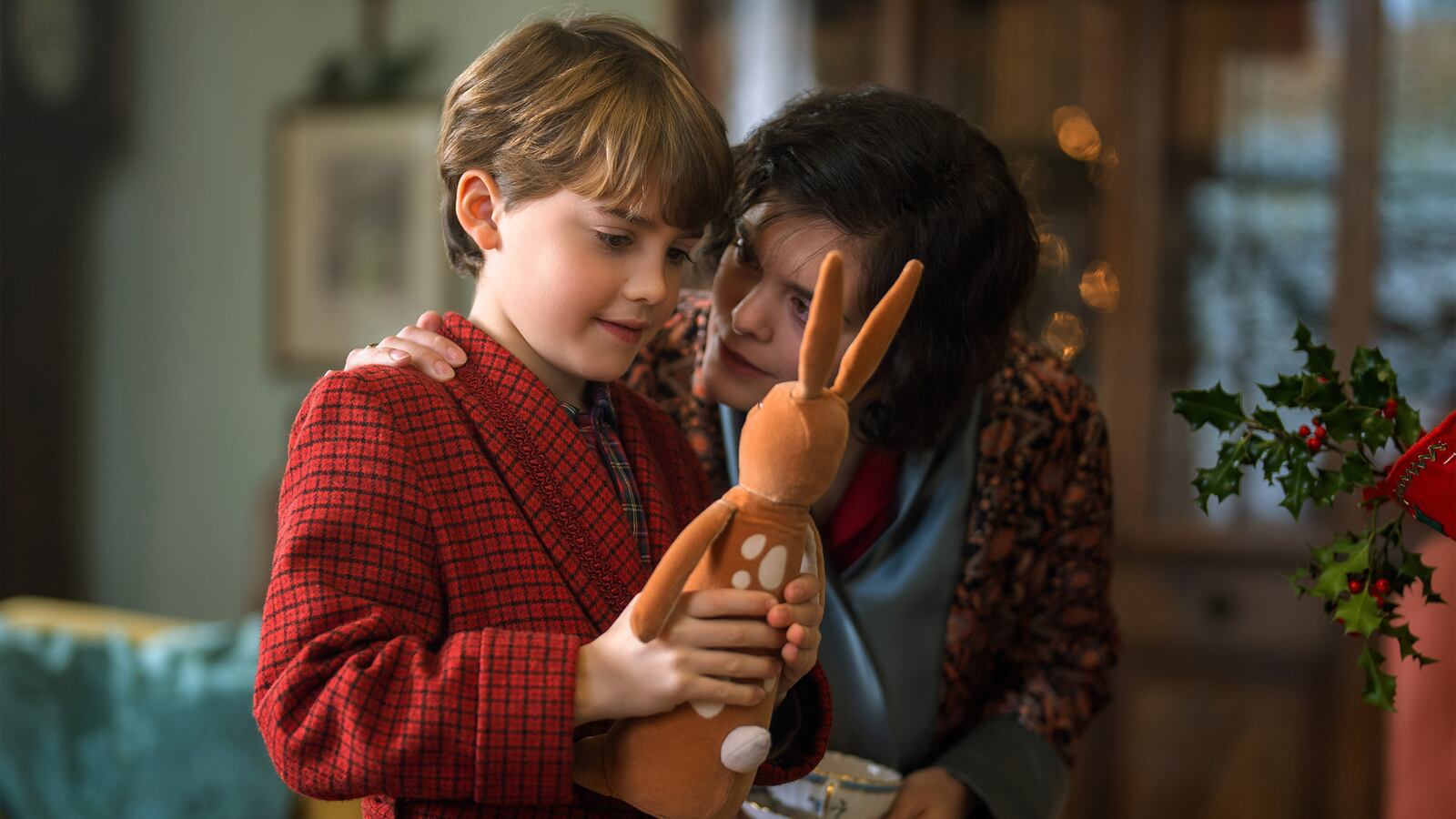Can you remember the best toy you received as a kid? Maybe it was a stuffed animal. Perhaps you can still feel the soft fur against your fingertips and the warmth it brought you when you snuggled it in bed. I’ll never forget the silky orange fuzz on a beloved tabby cat Beanie Babie I received as a child—nor will I cease to think about the feelings I had when, after we unwrapped presents, my mother read me The Velveteen Rabbit by Margery Williams Bianco for the first time. This classic story made me want to trade my kitten for a plush little hare.
Apple TV+’s new adaptation of the classic children’s book, a 45-minute special released Nov. 22, has reignited those feelings. There have been a number of Velveteen Rabbit adaptations in the past: Meryl Streep narrated the story for a 1985 video recording, the same year that Christopher Plummer also narrated a TV movie version. In the 1960s, Maurice Sendak also illustrated a new edition of the book, replacing William Nicholson’s original drawings from 1922—but this 2023 installment feels special.
Our new Velveteen Rabbit takes place in between three different settings. The little boy, William (Phoenix Laroche), lives in “reality,” which is filmed as a live-action story. But then the Velveteen Rabbit (Alex Lawther), which he received for Christmas, also comes alive thanks to stop-motion animation, which is used to show the rabbit chatting with other toys like the Wise Horse (Helena Bonham Carter) and the Playroom Fairy (Nicola Coughlan). When the rabbit and the boy interact, magic happens: They fall into an illustrated world where reality and imagination are one.
Tom Bidwell, who adapted The Velveteen Rabbit for the special, says these aesthetic choices were his idea from the start. He wasn’t sure, though, if his animation partners at Magic Light (The Gruffalo, Chic0 and Rita) would be game. “They always say that, on your first draft, you should write down what you want to do. It might not be possible, but stick it down anyway. Because if you don’t ask, you don’t get,” Bidwell tells The Daily Beast’s Obsessed over Zoom. “But they did it, the fools!”

William (voiced by Phoenix Laroche) and Velveteen Rabbit (voiced by Alex Lawther).
Apple TV+William and the rabbit pair go on plenty of adventures together and seem to have a limitless bond. But both want to know what happens after childhood ends and these imaginary worlds fade away. Below, Bidwell and executive producer Martin Pope explain how they made the real Velveteen Rabbit—and what it actually means to be “real,” anyways.
When were you both introduced to The Velveteen Rabbit?
Tom Bidwell: As a child. It’s one of those things that, like when you hear a Beatles song, [it feels like] you’ve always known it, in a weird way. It must have been very early, because I can’t remember when the first time I read it was. I was reintroduced to it when my colleague Bianca Rodway [and I] had an idea to do it. We came together at this meeting, and she said, “I’ve got a pitch for you.” And I said, “Well, I have a pitch for you as well.” And we both said The Velveteen Rabbit. We thought, “Well, that’s too fortuitous to not do.” The reason we both wanted to do it is because it’s just so it’s just got such a big heart to it. There’s not many pieces of IP that you approach, and you go, “Wow, this is just so much emotion. There’s so much to capture.”
Martin Pope: I had not known about it as a child, but I had been given it some years ago when we were doing voice recordings for The Gruffalo with Helena Bonham Carter. We couldn’t quite work out how to do it at the time. One of the things we do at Magic Light is try to find those great stories and see how we can make them work. We like to think that we can do animation and live action and anything in between. This seemed like a good sort of good one. We hadn’t quite realized how many in-betweens Tom would invent.

Lion (voiced by Clive Rowe), King (voiced by Paterson Joseph), Car (voiced by Lois Chimimba) and Velveteen Rabbit (voiced by Alex Lawther).
Apple TV+Right! You’ve got three artistics styles of Velveteen Rabbit here: live action, stop-motion animation, and the illustrations. How did you decide to create those three worlds in order to tell this story?
Bidwell: Well, I really wanted to give Martin a nervous breakdown.
Pope: [Laughs] That’s so touching—that was the intention here.
But Martin took on the challenge!
Bidwell: When you’re a kid, [the real world and the imaginary world], it all seems to blend and merge. We didn’t want to delineate too much between them. We wanted to make it feel like [everything] was just all part of this immersive world. The challenge was that we wanted scenes where the boy talks to the rabbit. That [needed] to be a different style, because it’s a different area of anthropomorphism.
Pope: When we first got the script, we didn’t quite know how we were going to do it. It is quite hard to imagine it. But the notion that the rabbit and the boy are on adventures together, where each of them can influence what’s going on—that seemed really important. There’s a huge [challenge] in trying to make a fur rabbit talk and do a jump, which is a whole other bit of animation. [We] spent many hours trying to work out.
How did you design the rabbit?
Pope: We had the full crew trying to make a live-action piece with three weeks of filming—with a young actor, period details, and snow. Tom did write that it starts at Christmas and it goes through a whole year, so we’ve got to do all the different seasons—and then get back to snow at the end. But while that was all happening, we were also designing the rabbit. We ended up having four different prop versions of the rabbit made. There’s the beautiful starting [toy], and then he gets a bit more beaten-up as he goes through the film. It is proper velveteen. We had to search for velveteen, make sure that that was right, with satin ears—it’s all very important to the original.
I so badly wanted to rub his soft belly.
Pope: [Laughs] Yes! We should obviously make little ones of these.
When you were rereading and adapting the original story, were there any lines that you felt needed to be included?
Bidwell: The Wise Horse’s speeches to the Velveteen Rabbit really sum up the whole film. Those who remember the book, they remember the content of those speeches. The toys are like a group of kids. They can’t quite figure out the rules. It’s like a group of kids trying to figure out emotions. But then it’s really that discussion around what’s real: “When a child loves you for a long, long time, not just to play with, but really loves you, then you become real.” That’s probably the most iconic line from the book.
People remember their parents reading this book to them during their childhood, which means they already have the characters’ voices locked in their heads. Did that make casting harder?
Bidwell: It hit a hard factory reset on my brain. I can no longer imagine it any other way than with those guys, or with the design of the rabbit that we’ve got. As soon as it becomes solid, the memory just gets rid of everything else. My ideas for the book were based on the wonderful original illustrations, and the team designed all the toys around that. I don’t think it was too far from what I had imagined it would be.

Velveteen Rabbit (voiced by Alex Lawther) and William (Phoenix Laroche).
Apple TV+This is a story that resonates with a lot of people in different ways. What does it mean to you?
Bidwell: So much to it is love and friendship, but the imagination aspect—that a child’s imagination is so vivid that it is more important than what we would say is real—that’s what the central theme of the book is. What does it mean to be real? Because an imagined thing is real to the kid. I see it in my kids, I see them talking to themselves and driving [toy cars] with race commentary. It’s a wonderful thing to capture and celebrate and make it a positive thing that kids want to keep going, hopefully into adulthood. Because I think if we all did that, then we’d all be probably better for it.
Pope: I do think that Tom’s brought out of the story just how liberating the love between the rabbit and the boy is. I just love the ending—the notion that they are both going off to do something wonderful with their lives. They’ve been enriched by being together, by imagining stories together.
The original Velveteen Rabbit book turned 100 last year. What do you think its legacy is today?
Bidwell: It is one of the all-time classic children’s stories, and I think one of the reasons for that is because it has sadness in it. It has difficult aspects to it, because children’s lives are full of challenging moments. We really embrace that in doing this, because it ultimately is about hope. That’s really why it’s lived so long in people’s hearts—the punch is a bit harder when [a children’s book] is sad than in grown-up literature.
Pope: But it’s sad with hope, you know? There are tears of sadness, but there are tears of joy as well. It treads a really interesting line. It makes people feel that they can go out and explore the world, and that there are wonderful things in the world. Often for kids, as Tom said, the world can be tricky. But to remind kids and families that the world is great is a wonderful thing in the book and, hopefully, in the film.
Everyone has their own take on the ending, where the rabbit becomes real. What’s your interpretation?
Pope: They both give each other something. The rabbit gives the boy hope. And in return, [the rabbit] is given a reality. It’s something he always wanted. We don’t spend ages wondering about what it’s like to be a rabbit. They’re both liberated.
Bidwell: I think that’s right—in the special friendships and relationships we have in our lives, oftentimes, they can come to an end. But what the other person gives us can endure beyond that. When we say goodbye to one thing, we say hello to another. Even though it is the end of the journey together, they’ve given each of these attributes. They’ve stepped into a new stage of [life].






